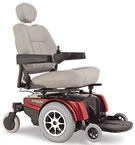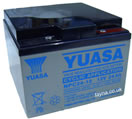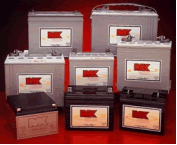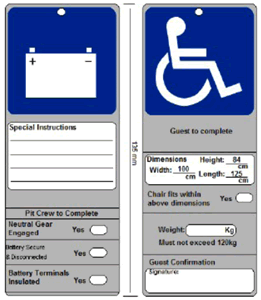Mobility aids such as wheelchairs or other battery-powered mobility devices with batteries




Wheelchairs or other battery-powered mobility devices are permitted. However, passengers must advise the Operator of their intention to transport these mobility devices. They must also specify the type of battery used. If the mobility aids contain one or more non-spillable batteries, then the battery/batteries need only be removed if the design of the mobility aid does not provide adequate protection against damage to them. If the mobility aid contains lithium battery(ies) that remain installed in the device, there is no Watt-hour limit for those batteries.
*** Electric mobility aids and wheelchairs may only travel with the passenger if the passenger has a permanent or temporary disability or for health or age reasons ***
A label must be also be completed by the Operator's staff and be attached to electric mobility devices after all mandatory inspections and handling are completed.
Example of a wheelchair & mobility device labels:

The problem with mobility devices and wheelchairs using a battery is the risk of short circuiting and the potential risk of fire.
For this reason mobility devices and wheelchairs must be prepared for transport as follows:
a) Short-circuiting
Most modern wheelchairs already have a protective cover on the battery terminals that ensures short-circuits cannot occur. However, if there is any doubt as to the effectiveness of the batteries' protective case or cover, then the battery leads must be disconnected and both the terminals and the leads must be insulated to ensure short-circuiting cannot occur. This can be done by placing electrical tape around the terminals and ends of the leads.
b) Accidental activation
If the battery already has an effective means of preventing short-circuiting in place, then the mobility device needs to be protected from accidental activation. Most modern mobility devices have a key to activate them. This can simply be removed to ensure accidental activation does not occur. If there is no key, then an alternative method must be looked for to ensure the device cannot activate accidentally.
There are three IATA Table 2.3.A extracts below that refer to passengers travelling with a wheelchair or mobility device. The extracts relate to the type of battery that powers the wheelchair or mobility device as indicated below:
1. The first extract applies to all mobility aids that have non-spillable batteries, but excludes lithuim batteries and spillable batteries. The batteries referred to in this case include things such as alkali-manganese, zinc-carbon, nickel-metal hydride and nickel-cadmium batteries.
2. The second extract applies only to lithium batteries and spillable batteries. Spillable batteries are like the ones that you have in your car.
3. The third extract applies to mobility devices with lithium ion batteries that are specifically designed to be removed.
Operator staff must identify the type of battery and mobility device and adhere to all restrictions. Usually the best person to ask about technical details is always the person presenting with the wheelchair. They should be able to provide all the information that is required but, as always, the specific Operator's Dangerous Goods Manual or other similar controlled documentation must be referred to for any Operator variations or procedures that may apply.
IATA Table 2.3.A Extract 1: All mobility aids not powered by lithium or spillable batteries

| - |
Permitted in or as carry-on-baggage |
NO
|
|
| - |
Permitted in or as checked baggage |
YES
|
|
| - |
The approval of the operator(s) is required |
YES
|
|
| - |
The pilot-in-command must be informed of the location |
YES
|
IATA Table 2.3.A Extract 2: Mobility aids powered by either a spillable battery or lithium ion batteries

|
|
- |
Permitted in or as carry-on-baggage |
NO
|
| - |
Permitted in or as checked baggage |
YES
|
|
| - |
The approval of the operator(s) is required |
YES
|
|
| - |
The pilot-in-command must be informed of the location |
YES
|
IATA Table 2.3.A Extract 3: Mobility aids powered by removable lithium ion batteries

|
|
- |
Permitted in or as carry-on-baggage |
YES |
| - |
Permitted in or as checked baggage |
NO |
|
| - |
The approval of the operator(s) is required |
YES
|
|
| - |
The pilot-in-command must be informed of the location |
YES
|
Note! Operators must secure mobility aids with installed batteries by use of tie-downs, straps or other restraint devices. The mobility aid, the batteries, electrical cabling and controls must be protected from damage including by the movement of baggage, mail or cargo. If a mobility device with a spillable battery cannot be loaded, stowed and secured in a upright position, the battery must be removed from the device and placed in a specially-designed battery box which must be leak-proof and secured by appropriate means to ensure its integrity. This battery box must travel independently of the mobility device.
Module 9 discusses the necessary points for loading wheelchairs and mobility devices with batteries onto aircraft more fully. In addition, the IATA Guidance on the Transport of Mobility Aids provides further guidance on the end-to-end processes for carriage of mobility aids.
Please note: new types of mobility aids and devices are constantly being invented. These aids may contain lithium batteries in areas that are not always immediately evident. For example, the e-Fix Mobility Aid contains a single lithium battery under the seat or at the back of the aid instead of in the wheel hubs. As a result of these differences, handling and loading of the newer types of mobility aids may vary from others.
Always check the specific Operators handling requirements to ensure safety when loading onto any aircraft.

